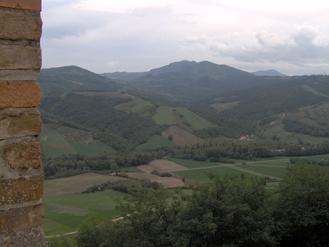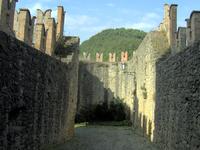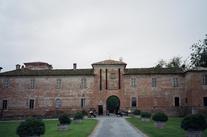Italy
the Douglas Scotti of the 8th century
|
 |
| The medieval fortress at Vigoleno afforded this familiar view and perhaps a feeling of déjà vu, of the Stirone River below; memories from Spiritual visions reawakened the author to another lifetime spent in Northern Italy during the 9th century as Katrina Isabella Douglas Scotti |
|
|
 |
| A 19th century painting of the medieval castle at Fombio depicted a battle scene during the time of Napoleon’s march on Piachenza. Spirit showed the author a three story tower in visions. A visit to the ruined castle in northern Italy revealed the remains of a three story inner tower and the medieval footings of other buildings that Spirit also provided. |
|
|
Visiting northern Italy in the fall of 2005 was the brainchild of the late Lt. Col. Gavin Douglas, FSAScot, DFC. He convinced this author to bring my camera and a sense of adventure to find the ancestral homes of the Douglas Scotti of the 8th century in and around the Ducato of Piacenza. Gavin was the would-be Duke of Drumlanrig but for a tawdry bit of bedroom antics on the part of his several great, great grandfather. That laird fell in love with a younger woman and left his wife; paying the Pope great sums for an annulment. Through that action, the eldest Douglas son born of the first wife was disinherited. That unfortunate, former heir was Gavin’s great, great grandfather. The old laird then married his mistress and she immediately solidified their union by giving birth to a boy, the future heir to the Drumlanrig estates.
I became the chauffeur as 93 year old Gavin led us through Italy with the swagger and presence of the old Duke himself, acquainting us all with the lands of our ancestors. Gavin even secured a luncheon invitation to Agazzano Castle with “our cousin Mauri”. Little did I know that “Mauri” was actually the Prince and Marquess Maurizio Ferrante of the respected Gonzaga family. His most gracious mother, the late Princess Luisa Angissola Scotti opened her home, the summer palace at Agazzano, to us as if we were family. But then, we were in the Spiritual sense, as members of the 8th century Douglas Scotti “clan”.
|
 |
| The title Lord of Douglas and Vigoleno was created in the mid-fourteenth century. The ancient tower guards the walled medieval town overlooking the Stirone. Odd digital photos appeared with the same pink hues that prevailed in other Douglas sites throughout history. Finding the charter of the mid 1300’s in Italy verified the information from Spirit, divulged by William the first Earl of Douglas. |
|
|
 |
| Bastardina was another Douglas Scotti fortress in the Ducato of Piacenza. As we took photos of the interior, light images appeared, as if validating the earlier visions from Spirit. |
|
|
 |
| The thirteenth century tower was actually made of bricks! From the shuttered windows of the dining room a stunning view took hold of this author; it was the exact scene of a recent vision where I saw a man dressed in a plain tunic, with a long moustache and other facial hair came to kneel before me. I knew he was asking for my hand in marriage. And now, in 2005, I was looking out to a carbon copy of that landscape. |
|
|
 |
| Spirit told me that proof of the relationship between the 9th century Guillelmo de Duglas and the Douglas Scotti of Piacenza would be found in the documents and at the fortresses, some in ruins, in Italy. I sent this tiled image of the Douglas Scotti armorials to Stuart Morris of Balgonie and he provided the description: “Azure, a bend Argent, between two mullets of six points Or.” The seal embedded in the tiles also included the strap and buckle of the Scottish tradition. The emblem was originally three stars as is the original Douglas armorials but later changed to two stars in deference to their 14th century allegiance to the Guelph party. |
|
|
 |
| The fortress at Vigoleno was part of the medieval holdings of the Lord of Douglas and Vigoleno. Much evidence was in place here where once again the original armorial bearings of the Douglas Clan that were modified to two stars and a bend decorated the ancient structures. |
|
|
|